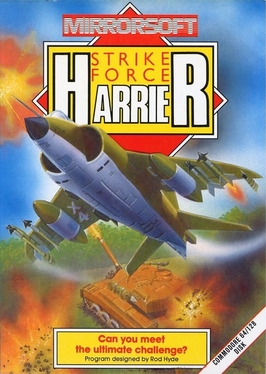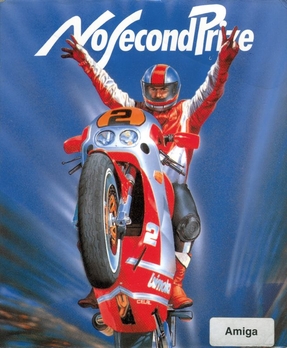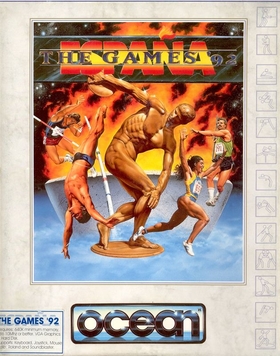
Rick Dangerous is a platform game developed by Core Design for the Acorn Archimedes, Amiga, Atari ST, Amstrad CPC, ZX Spectrum, Commodore 64, and MS-DOS. The game was released in 1989 and published by MicroProse on the Firebird Software label in the UK, and on the MicroPlay label in America. It was also published in Spain by Erbe Software. Later, it was released with two other games, Stunt Car Racer and MicroProse Soccer, on the Commodore 64 Powerplay 64 cartridge. The game was followed by a sequel, Rick Dangerous 2, in 1990. Loosely based on the Indiana Jones film franchise, the game received mixed reviews from critics.

Llamatron is a multidirectional shooter video game programmed by Jeff Minter of Llamasoft and released in 1991 for the Atari ST and Amiga and in 1992 for MS-DOS. Based on Robotron: 2084, players of Llamatron control the eponymous creature in an attempt to stop an alien invasion of Earth and rescue animals—referred to as "Beasties"—for points. Players advance by destroying all of the enemies on each level using a laser that fires automatically in the direction that the Llamatron is moving. Various power-ups exist to aid the player in defeating the wide variety of enemies and obstacles they face along the way.

Soccer Kid is a 1993 side-scrolling platform game developed and published by Krisalis Software in Europe for the Amiga. The player assumes the role of the titular main protagonist who travels across several countries around the world to repair the World Cup by retrieving pieces that were scattered by the alien pirate Scab, the main antagonist who failed to steal and add it to his trophy collection in a robbery attempt. Its gameplay mainly consists of platforming and exploration elements, with a main single-button or two-button configuration, depending on the controls setup.

Star Goose is a vertically scrolling shooter that was published for the Amiga, Atari ST, and MS-DOS by Logotron in 1988. The player controls Scouser-Gitt, who pilots the eponymous Star Goose, a vessel that has been commissioned to scour the planet Nom and collect 48 crystals. Players must collect all six crystals in each of the game's eight levels to advance, while at the same time avoiding or destroying enemies and maintaining their shield, ammunition, and fuel levels. The game's surfaces are contoured, which affects the way that bullets travel, and contain tunnels that switch modes to a three-dimensional perspective where the player can replenish their resources.

Epic is a space combat simulation game developed by Digital Image Design and published by Ocean Software for the Commdore Amiga and Atari ST in early 1992. A port to MS-DOS also appeared in the same year, followed by a version for the NEC PC-9801 in 1993. A sequel, titled Inferno, was released in 1994 for PCs only.

Obsession is a pinball video game developed and originally published by Unique Development Sweden for the Atari STe on December 2, 1994. It is the first video game to be created by UDS and one of the last official releases for the Atari ST platform after being discontinued in 1993 by Atari Corporation. In the game, players can choose between any of the four available playfields, both of which have their own thematic and main objectives in order to obtain the highest score possible.

Ruff 'n' Tumble is a 1994 platform run and gun video game developed by Wunderkind and published by Renegade Software for the Amiga. An Amiga CD32 version was planned but never released. It was the only game made by Wunderkind. It stars Ruff Rodgers, embarking on a quest across an alien planet to reclaim his marbles after one of them fell into a portal inside a rabbit hole while playing with his collection in the park, and free the planet from Dr. Destiny and his Tinhead army. Through the journey, the player explores and search through each level for items and power-ups, as well as fight enemies and defeat bosses.

Space Gun is a 1990 first-person shooter arcade game released by Taito. The game is set aboard a crippled space station that has been overrun by hostile alien creatures. The objective is to rescue human crew members while destroying the alien creatures. The game lets the player shoot limbs off the creatures, resulting in blood splatters.

Fun School is a series of educational packages developed and published in the United Kingdom by Europress Software, initially as Database Educational Software. The original Fun School titles were sold mostly by mail order via off-the-page adverts in the magazines owned by Database Publications. A decision was made to create a new set of programs, call the range Fun School 2, and package them more professionally so they could be sold in computer stores around the UK. Every game comes as a set of three versions, each version set to cater for a specific age range.

HeroQuest is a video game based on the HeroQuest board game.

Ishar 2: Messengers of Doom is a 1993 role-playing video game developed and published by Silmarils for the Amiga, Atari ST, MS-DOS, Atari Falcon, and Macintosh home computers. It is the second entry in the Ishar trilogy.

Robinson's Requiem is a 1994 survival simulation video game developed and originally published by Silmarils exclusively in Europe for the Atari ST, Atari Falcon and Amiga. Taking place in the 22nd century where Earth and colonized planets are facing overpopulation, the game sees players assuming the role of Robinson officer Trepliev 1 from the Alien World Exploration department in his attempt to escape imprisonment from the fictional planet of Zarathustra alongside another AWE Robinson named Nina1, while facing several hostile creatures and dangers in order to survive.
Scetlander was a software publisher which released titles for various 8- and 16-bit home computer systems in the 1980s and 1990s.

Ace is a combat flight simulator video game published for the Commodore 64, VIC-20, and Plus/4 in 1985 by Cascade Games. It was ported to the Amstrad CPC, Amstrad PCW, Amiga, and ZX Spectrum.

P-47: The Phantom Fighter is a 1988 horizontally scrolling shooter arcade video game originally developed by NMK and published by Jaleco. Set during World War II, players control a Republic P-47 Thunderbolt fighter aircraft to face against the Nazis, who are occupying multiple countries around the world. Its gameplay involves destroying waves of enemies, picking up power-ups and new weapons, and destroying bosses. It ran on the Mega System 1 hardware.

Brutal Sports Football is a 1993 sports video game developed by Teque London and originally published by Millennium Interactive for the Amiga. It was re-published for MS-DOS and Amiga CD32, and later became the first third-party title published for the Atari Jaguar. The first entry in the Brutal Sports series, the game is a fictional style of football played against human or computer-controlled opponents. It features a different take on american football by emphasising the violent aspect of the sport.

Strike Force Harrier is a 1986 combat flight simulation video game designed by Rod Hyde and published by Mirrorsoft for the 8-bit home computers. 16-bit ports were released later.

No Second Prize is a 1992 racing video game developed and published by Thalion Software for the Amiga and Atari ST.

Advantage Tennis is a 1991 tennis video game developed and published by Infogrames for the Amiga, Atari ST, and MS-DOS.

The Games '92: España is a 1992 sports video game developed by Creative Materials and published by Ocean Software for the Amiga, Atari ST, and MS-DOS.



















